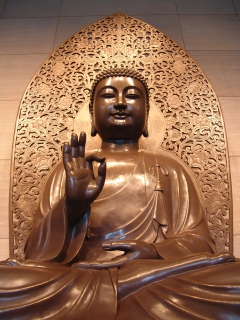The Grand Buddha Hall

The Buddha statues are modeled on the Aksshobhya Buddha statue of the Four Gate Pagoda (" Si-men-ta") at Shentong Monastery in Shandong Province, China. The mudras (hand gestures) represent each Buddh'as original vows. In the center in Shakyamuni Buddha, whose left hand forms the "meditation mudra", and right hand the "Dharma-teaching mudra". On the left, Amitabha Buddha places his right palm over his left in the "Amitobha mudra", denoting infinite light and an immesurable lifespan. To the right is the Medicine Buddha, the left hand holding a vase of ambrosia, and the right hand forming a "wish-granting mudra", symbolizing answering sentient beings' prayers.
On Master Sheng Yen's instruction, the central panels of the pedestals were engraved with Dharma wheels, surrounded by rare, native Taiwanese animals and plants. This symbolizes how animals, too, come to listen to the Buddha's teaching. The representation of local natural images indicates protecting the environment and caring for life.
An underground palace six meters beneath the statues houses over 300 pieces of contemporary Buddhist artifacts, objects, and texts. It aims to preserve traces of Buddhist civilization and culture, and the palace will not be opened until 3,000 A.D. Of religious and artistic value, the Buddha Hall represents a spiritual center and the inheritance of Buddhist traditions.
Architecture of the Grand Buddha Hall:
Height of the interior: 16 meters
Area of the interior: about 1322 square meters
Capacity: about 2,000 persons
The Three Buddha statues:
Material: bronze
Height: 3.7 m. in total
Weight: 2.5 metric tons
